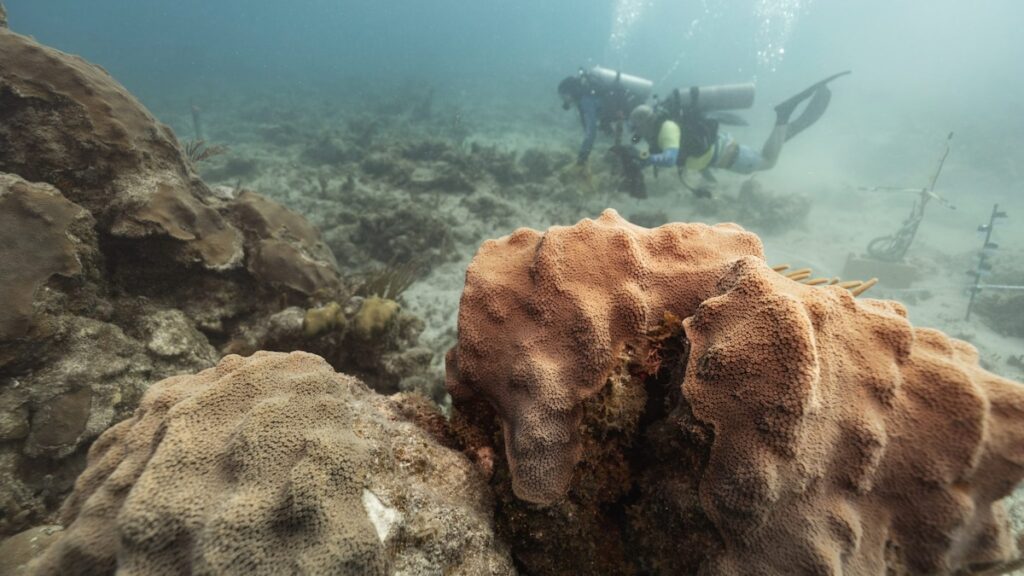Playing Healthy Reef Sounds Underwater Could Help Save Corals, Study Finds
5 min read
A reef that has been degraded – whether by coral bleaching, disease, or direct human impacts – can’t support the same diversity of species and has a much quieter, less rich soundscape. Dan Mele / Woods Hole Oceanographic Institution
Founded in 2005 as an Ohio-based environmental newspaper, EcoWatch is a digital platform dedicated to publishing quality, science-based content on environmental issues, causes, and solutions.
Healthy coral reefs are complex ecosystems that serve as the feeding and spawning habitat for thousands of fish, molluscs, crustaceans and many other marine species. Reefs are not only colorful, but full of sounds, and it is this vast array of noises that is the focus of a new study by scientists at the Woods Hole Oceanographic Institution (WHOI).
The research team found that using underwater speakers to play soundscapes made by thriving corals could help damaged and degraded reefs by encouraging coral larvae to make their homes there.
“A healthy coral reef is noisy, full of the croaks, purrs, and grunts of various fishes and the crackling of snapping shrimp. Research suggests that larval animals use this symphony of sounds to help them determine where they should live and grow,” a press release from WHOI said.
A reef that has experienced coral bleaching or been degraded by human impacts or disease is unable to support as many species, resulting in a quieter and less diverse soundscape. The researchers demonstrated that coral larvae responded to the broadcasting of healthy reef noises at degraded reefs by settling them at much higher rates.
“What we’re showing is that you can actively induce coral settlement by playing sounds,” said first author of the study Nadège Aoki, a WHOI doctoral candidate, in the press release. “You can go to a reef that is degraded in some way and add in the sounds of biological activity from a healthy reef, potentially helping this really important step in the coral life cycle.”
Since corals become immobile as adults, the larval stage is the only time they are able to choose their habitat. Coral larvae follow the currents, drifting or swimming in search of suitable conditions where they can affix themselves to the seafloor. Earlier research had demonstrated that light and chemical cues have the ability to influence their decisions, but the new study adds sounds to the combination of factors.
“We’re hoping this may be something we can combine with other efforts to put the good stuff back on the reef,” Aoki said, as The Guardian reported. “You could leave a speaker out for a certain amount of time and it could be attracting not just coral larvae but fish back to the reef.”
The study involved a single experiment that was conducted twice in the United States Virgin Islands in June and July of 2022. The researchers collected a species of coral larvae known as “mustard hill coral” due to its yellow color and cauliflower-like bumps, distributing them at three reefs on the coast of the island of St. John.
Tektite, one of the reefs selected, was relatively healthy, while Salt Pond and Cocoloba had a lower fish population and sparse coral cover.
After installing an underwater speaker system at Salt Pond, the scientists placed larvae cups in four locations from 3.28 feet to 98.4 feet away from the speakers. For three nights, healthy reef sounds that had been recorded at Tektite nine years earlier were broadcast. Similar installations were set up at the other reefs without any sounds.
After collecting the cups, the team discovered that much more larvae had settled at Salt Pond. Coral larvae had settled at an average rate from 1.7 to seven times more often in the sound-filled environment.
“The fact that settlement is consistently decreasing with distance from the speaker, when all else is kept constant, is particularly important because it shows that these changes are due to the added sound and not other factors,” said Aran Mooney, lead author of the study and a marine biologist with WHOI, in the press release. “This gives us a new tool in the toolbox for potentially rebuilding a reef.”
The Tektite and Cocoloba reefs had similar settlement rates to each other. A 2017 study showed higher rates at Tektite, which had experienced a major bleaching event, coral disease and several hurricanes in recent years.
“We seem to have lost some of the complexity of Tektite’s soundscape over the last decade,” Aoki said in the press release. “It could be that conditions there are not as good as we thought they were, but we don’t know for sure.”
The researchers pointed out that Tektite’s reduction in settlement rates is an example of the many threats facing coral reefs, as well as the necessity of scalable and timely solutions.
The study, “Soundscape enrichment increases larval settlement rates for the brooding coral Porites astreoides,” was published in the journal Royal Society Open Science.
More than a quarter of the planet’s marine animals are supported by coral reefs. They also provide tourism and food for millions of people and protect coastlines from storms and powerful waves.
It has been estimated by scientists that half of Earth’s coral reefs have been destroyed in the past three decades.
The research team has hope that their work could be used to aid coral restoration. For example, coral reef soundscapes could help increase larvae settlement rates in nurseries, or be broadcast at wild reefs to improve or maintain existing populations of corals.
“Replicating an acoustic environment is actually quite easy compared to replicating the reef chemical and microbial cues which also play a role in where corals choose to settle,” said Amy Apprill, a study co-author and WHOI microbial ecologist, in the press release. “It appears to be one of the most scalable tools that can be applied to rebuild reefs, so we’re really excited about that potential.”
Subscribe to get exclusive updates in our daily newsletter!
By signing up, you agree to the Terms of Use and Privacy Policy & to receive electronic communications from EcoWatch Media Group, which may include marketing promotions, advertisements and sponsored content.





